
Poker has been a popular game for many years. Some think it evolved from the French game Poque and the Persian game As-Nas. For many people, it is just a fun game to play, while for others, it can be their full-time profession. While there are many different ways to play poker, one aspect that is true throughout all poker games is hand rankings. One of the first things you’ll need to learn in poker as a beginner is the different hands and how they rank. In this post, we will dive into all of the different poker hands so that you can look like an expert the next time you play.
STANDARD POKER RANKINGS
A standard deck of cards has 52 in a pack. Individually cards rank, high to low:
- Ace
- King
- Queen
- Jack
- 10
- 9
- 8
- 7
- 6
- 5
- 4
- 3
- 2
In standard poker (in North America), there is no suit ranking. A poker hand has 5 cards in total. Higher-ranked hands beat lower ones, and within the same kind of hand, higher-value cards beat lower-value cards.
#1 ROYAL FLUSH

The Royal Flush is the best (and rarest) hand you can get in poker. It consists of the highest cards in sequence of the same suit, starting with the Ace. In fact, the hand is A-K-Q-J-10 and is unbeatable!
#2 STRAIGHT FLUSH

In games without wild cards, this is the second-highest-ranking hand. It consists of five cards in sequence of the same suit. When comparing flushes, the hand with the highest value high card wins. Example: 5-6-7-8-9, all spades, is a straight flush that beats 2-3-4-5-6. Flushes can not turn the corner; for example, 3-2-A-K-Q is not a straight flush.
#3 FOUR OF A KIND (QUADS)

A four-of-a-kind is four cards of equal rank, for example, four jacks. The kicker, the fifth card, may be any other card. When comparing two four of a kind, the highest value set wins. For example, 10–10–10–10-2 beats 5–5–5–5-J. If two players have a four-of-a-kind of equal value, the player with the highest-ranking kicker wins.
#4 FULL HOUSE (BOAT)

A full house consists of 3 cards of one rank and 2 cards of another. The three cards value determines rank within Full Houses; the player with the highest rank 3 cards wins. If the three cards are equal in rank, the pairs decide. Example: Q–Q–Q-3-3 beats 10–10–10-A-A, BUT 10-10-10-A–A would beat 10-10-10-J–J.
#5 FLUSH

Any five cards of the same suit. The highest card in a flush determines its rank between other flushes. If those are equal, compare the next highest cards until you can determine a winner.
#6 STRAIGHT

Five cards in sequence from different suits. The hand with the highest ranking top card wins within straights. Ace can either be a high card or a low card, but not both. The wheel, or the lowest straight, is 5-4-3-2-A, where the top card is five.
#7 THREE OF A KIND (TRIPLETS/TRIPS)

A three-of-a-kind is three cards of equal rank and two other cards (not of equal rank). The three-of-a-kind with the highest rank wins. Although, in the event they are equal, the high card of the two remaining cards determines the winner. For example, K-K-K-5-8 beats K-K-K-6-4.
#8 TWO PAIRS

A pair is two cards that are equal in rank. A hand with two pairs consists of two separate pairs of different ranks. For example, K-K-3-3-6, where 6 is the odd card. The hand with the highest pair wins if there are multiple two pairs regardless of the other cards in hand. To demonstrate, K–K-5-5-2 beats Q–Q-10-10-9 because K > Q, despite 10 > 5.
#9 PAIR

A hand with a single pair has two cards of equal rank and three other cards of any rank (as long as none are the same.) When comparing pairs, the one with the highest value cards wins. If they are equal, then compare the highest-value oddball cards. If those are equal, continue comparing until a win can be determined. An example hand would be 10-10-6-4-3, which would beat 10-10-6-3-2.
#10 HIGH CARD (NOTHING/NO PAIR)
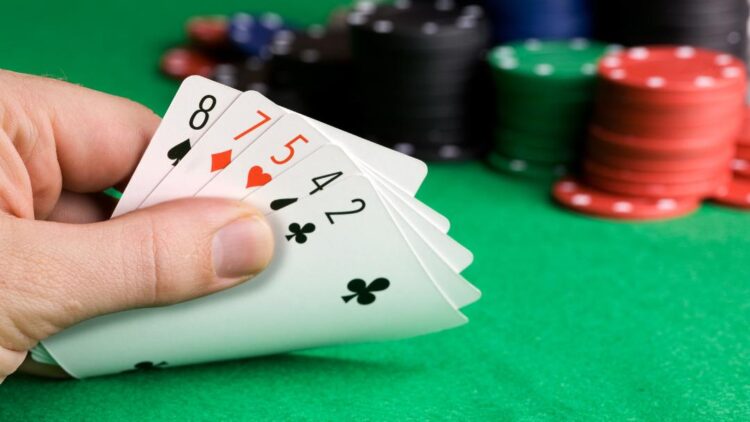
If you get very unlucky or if you’re just not trying anymore, then you might just get this hand. This is when your cards don’t fit any of the categories, don’t form any sequence, and are at least two different suits; this hand is called a high card. The highest value card, when comparing these hands, determines the winning hand. This is especially bad when playing strip poker!

LOW POKER HAND RANKING
Now, you’ve got all the rankings in mind. However, not all poker games are created equally! Some games actually flip the poker rankings around and use the lowest-ranking hand as the best possible hand. These are called lowball or high-low games. The strategy for these games can get a bit more confusing since everything is backwards. Let’s go over these rankings.
In order to understand these rankings, you have to understand the lingo. You call a low hand with no combination by its highest-ranking card. For example, a hand with 10-6-5-3-2 is described as “10-down” or “10-low.”
ACE TO FIVE
This is the most common system for ranking low hands. Aces are always a low card, and straights and suits do not matter. Like in standard poker, you always judge cards, starting with the highest card and moving down.
1. FIVE LOW

Under the Ace to Five rules, 5-4-3-2-A is the best hand.
2. SIX LOW
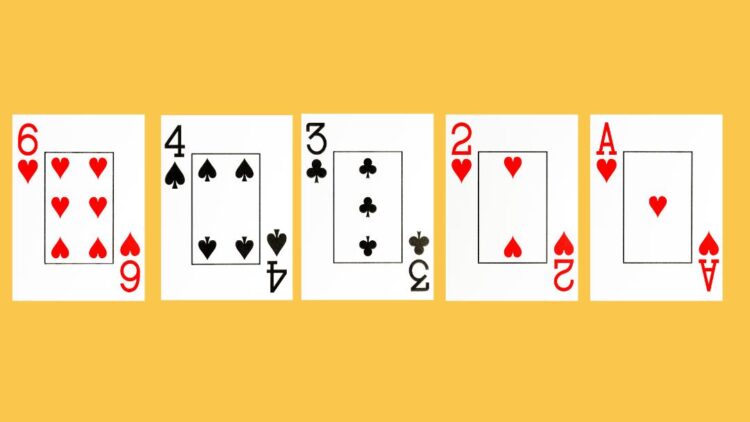
The next best hand is the six low. It is any unpaired hand with six as the highest card. However, if two players have a six low, you break the tie based on the next highest card. For example, 6-4-3-2-A beats 6-5-3-2-A AND beats 7-4-3-2-A. This is because 4 < 5 and 6 < 7.
3. SEVEN LOW
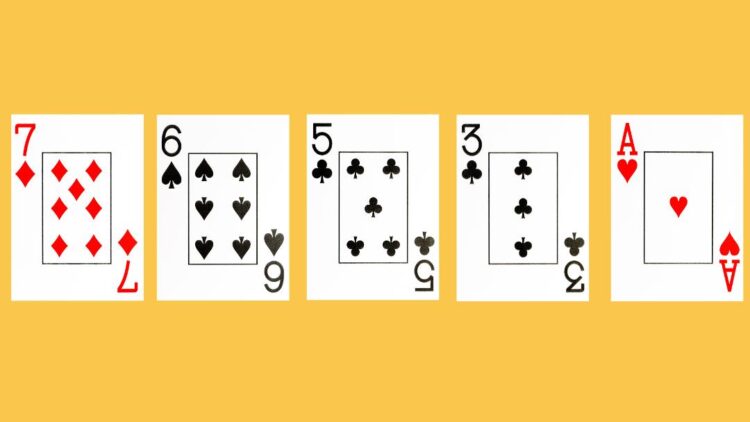
This is any unpaired hand with the seven as the highest card. The same rules apply as above. So if two players have this hand, judge based on the next highest card. Remember, the lower card wins.
4. EIGHT LOW

Eight low is any unpaired hand, with an eight as the highest card. The same rules apply as above. The next lowest card after the eight is the winner.
In high-low poker games, there is often a condition called “eight or better” that qualifies players to win part of the pot. Although, their hand must have an 8 or lower to be considered. The worst hand under this condition would be 8-7-6-5-4.
DUECE TO SEVEN
The hands under this system rank almost the same as in standard poker. It includes straights and flushes, and the lowest hand wins. However, this system always considers aces high cards (A-2-3-4-5 is not a straight.)
1. SEVEN LOW

Under this system, the best hand is 7-5-4-3-2 (in mixed suits), a reference to its namesake. As always, the highest card is compared first.
2. EIGHT LOW

This is the next best hand in Duece to seven. Five unpaired cards of different suits with an eight as the highest card.
3. NINE LOW

This is the third-best hand, with five unpaired cards of different suits, with a nine as the highest card.
4. 10 LOW

Finally, you have the 10 low, which is, yes, you guessed it. Five unpaired cards of different suits with 10 as the highest card.
These are the best low-hand hands in Deuce to seven. Remember, the winner is the player with the lowest hand.
TEXAS HOLD ‘EM HAND RANKINGS
Of course, you know we couldn’t skip out on Texas Hold ‘em. If you’ve ever played before, you know that many factors play into the outcome of a game. The two cards you get dealt are not enough to determine what happens.
With all that said, there are a few starting hands that can give you a slight advantage in your next game.
1. POCKET ACES – A, A

Pocket Aces are the most powerful starting hand in Texas Hold ‘em. No matter what the game format is, this will always be a fantastic hand to have.
2. POCKET KINGS – K, K
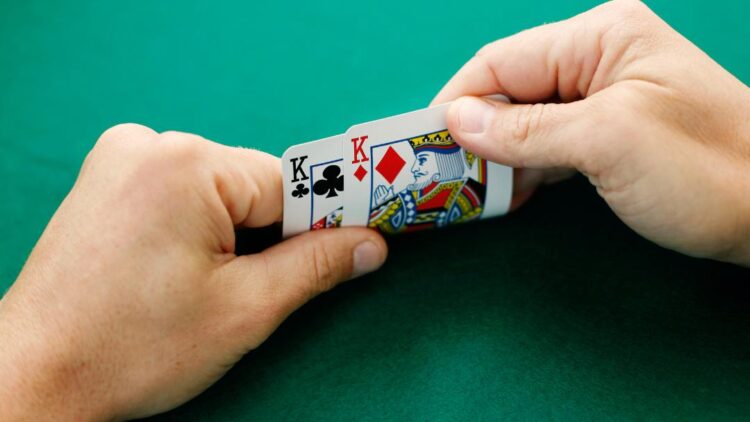
This is the second best hand you can start out with, two Kings. It gives you a great advantage before the community cards get dealt.
3. POCKET QUEENS – Q, Q

Naturally, the next best hand is pocket queens. A pair of Queens also gives you quite a good advantage when starting out.
4. ACE KING SUITED – A, K

This is the fourth best hand you can start with in hold em. An Ace and a King of the same suit are some players’ preferred hands for starting since they offer you more ways to win the pot or beat other hands.
5. POCKET JACKS – J, J

A pair of jacks is not as powerful as a starting hand like K,K, or A,A, but it is still a decent hand to have when starting out.
6. ACE KING OFF SUIT – A, K
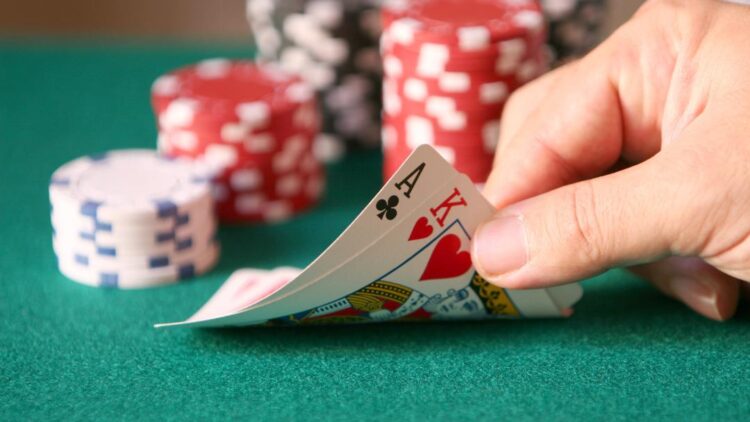
This is when you have an Ace and a King, not of the same suit. It is still a great hand, but it is just not as powerful as the Ace King Suited.
HAND RANKINGS WITH WILD CARDS
Wild cards can substitute any card you need to make a particular hand. Jokers are often used as wild cards and are added to the deck (this means playing with 54 as opposed to 52 cards). If players stick with a standard deck, they can choose 1+ card as the wild card. For example, all the twos in the deck (deuces wild) or the “one-eyed jacks” (the jacks of hearts and spades).
Wild cards can be used to:
- substitute any card not in a player’s hand OR
- make a special “five-of-a-kind”
1. FIVE OF A KIND

Five of a Kind is the highest hand of all and beats a Royal Flush. When comparing five of a kind, the highest value five cards win. Aces are the highest card of all.
2. THE BUG
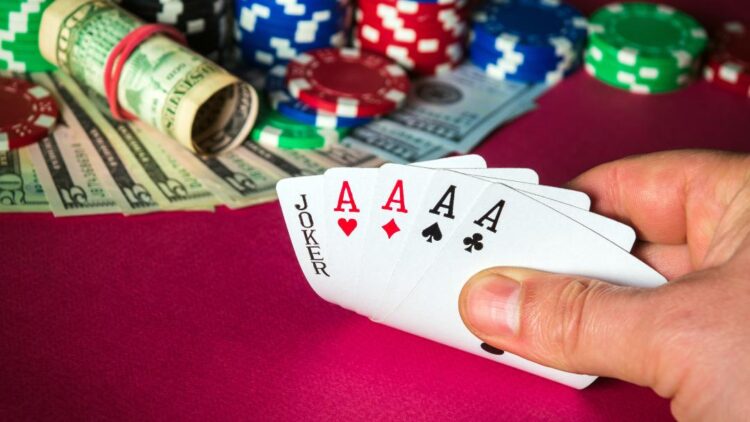
Some poker games, most notably five-card draw, use the bug. The bug is an added joker which functions as a limited wild card. It may only be used as an ace or a card needed to complete a straight or a flush. Under this system, the highest hand is a five-of-a-kind of aces, but no other five-of-a-kind is legal. In a hand, with any other four-of-a-kind, the Joker counts as an ace kicker.
WILD CARD RULES IN LOW POKER
During a low poker game, the wild card is a “fitter,” a card used to complete a hand that is of the lowest value in the low hand ranking system used. In standard poker, 6-5-3-2-joker would be considered 6-6-5-3-2. In ace-to-five, the wild card would be an ace, and in deuce-to-seven, the wild card would be a 7.
LOWEST CARD WILD
Home poker games may play with the player’s lowest or lowest concealed card as a wild card. This applies to the card of the lowest value during the showdown. Aces are high, and twos are low under this variant.
DOUBLE ACE FLUSH
This variant allows the wild card to be ANY card, including one already held by a player. In addition, it allows for the opportunity to have a double ace flush.
NATURAL HAND V. WILD HAND
There is a house rule that says a “natural hand” beats a hand that is equal to it with wild cards. Hands with fewer wild cards beat hands with more wild cards. However, you must agree on this before the game starts.
INCOMPLETE HANDS
If you are comparing hands in a variant of poker in which there are less than five cards such as three card poker, there are no straights, flushes, or full houses. There are only four-of-a-kind, three-of-a-kind, pairs (2 pairs and single pairs), and high cards. Although, if the hand has an even number of cards, there may not be a kicker.
Examples of scoring incomplete hands:
10-10-K beats 10-10-6-2 because K > 6. However, 10-10-6 is beaten by 10-10-6-2 because of the fourth card. Also, a 10 alone will beat 9-6. But 9-6 beats 9-5-3, and that beats 9-5, which beats 9.
RANKING SUITS

In standard poker, suits are NOT ranked. If there are equal hands, the pot will be split. However, depending on the variant of poker, there are situations when suits must rank cards. For example:
- Drawing cards to pick player’s seats
- Determining the first better in stud poker
- In the event an uneven pot is to be split, determining who gets the odd chip.
Typically, in North America (or for English speakers), suits are ranked in reverse alphabetical order.
- Spades (highest suit), Hearts, Diamonds, Clubs (lowest suit)
Suits are ranked differently in other countries/ parts of the world:
- Hearts (high suit), Spades, Diamonds, Clubs (low suit) – Greece and Turkey
- Hearts (high suit), Diamonds, Spades, Clubs (low suit) – Austria and Sweden
- Hearts (high suit), Diamonds, Clubs, Spades (low suit) – Italy
- Diamonds (high suit), Spades, Hearts, Clubs (low suit) – Brazil
- Clubs (high suit), Spades, Hearts, Diamonds (low suit) – Germany
POKER HAND PROBABILITY
If you’re a math genius, then maybe using probabilities could help you in a game. Keep in mind that in poker, there are 2,598,960 combinations you can make! Let’s go over the odds of getting each hand in a game of five-card draw.
| HAND | # OF WAYS | PROBABILITY |
|---|---|---|
| ROYAL FLUSH | 4 | 0.000154% |
| STRAIGHT FLUSH | 40 | 0.00139% |
| FOUR-OF-A-KIND | 624 | 0.02401% |
| FULL HOUSE | 3,744 | 0.1441% |
| FLUSH | 5,108 | 0.1965% |
| STRAIGHT | 10,200 | 0.3925% |
| THREE-OF-A-KIND | 54,912 | 2.1128% |
| TWO PAIR | 123,522 | 4.7539% |
| PAIR | 1,098,240 | 42.2569% |
| NO PAIR/HIGH CARD | 1,302,540 | 50.1177% |
We know this is a comprehensive list. It seems like there are as many variations in poker games as there are hands. We hope this article helps you better understand the different hands in Poker. You can also check out our rules of betting so you know when you’re doing good in the game. If you’re looking for something else to do during your game night, check out the best board and card games.
FAQ
What Is Statistically the Best Hand in Poker?
The best hand in poker is the Royal Flush which is the A,Q,K,J,10 all in the same suit.
What Is the Unluckiest Hand in Poker?
In five card poker the unluckiest hand is a random set of low cards, with no pair. If you are playing Texas Hold ’em, then 2 and 7 off suit is the unluckiest hand.
In Poker what Is the Dead Man’s Hand?
Dead man’s hand is a hand of two Aces and two eights. It comes from the legend that the famous gunfighter Wild Bill Hickock had this poker hand when he was killed during a poker game.
- 20+ Epic Outdoor Drinking Games - June 28, 2024
- 30 Gifts for Board Game Lovers - June 27, 2024
- 33 Games for Church Youth Group - June 21, 2024